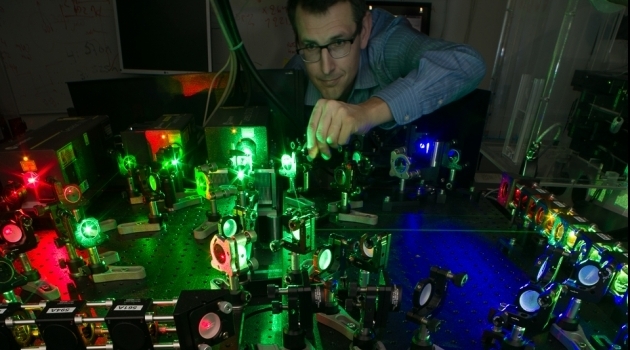A glimpse inside the bustling interior of a cell
The inside of a cell is an exciting, eventful place. Here are all of our genes and all of the proteins that regulate them, the so-called transcription factors. Johan Elf, Professor of Physical Biology at the Department of Cell and Molecular Biology at Uppsala University, is interested in the principles that coordinate life at the molecular level.
His research team examines how gene expression is coordinated by proteins called transcription factors, how biomolecules find one another in the cell’s bustling interior and how the copying of the cell’s genome is synchronised with cell division. The goal is to find simple and general principles that describe the cell’s control system.
‘We use a traditional approach, but with new methods’, says Johan. ‘We formulate meticulous predictions and then develop the methods needed to test them.’
Johan was the first person ever to witness individual transcription factors binding to their target genes in living bacteria.
Making predictions that are so clear that it is possible to determine when they are wrong requires both good physical models and the development of new simulation methods. The real challenge for the group, however, is to develop accurate measuring methods. To achieve sufficient temporal and spatial resolution, the group works with methods to study individual molecules in living cells. The results are often unexpected.
‘If you can just show that the measurement is good enough, not getting the expected results is just as interesting, if not more, as when the measurements do support a certain model,’ says Johan. ‘That’s when you really learn something, even if it can be difficult to find a new model that meets all the requirements from previous experiments and that is also physically possible.’
Transdisciplinary research is necessary, he says, and the research team has a wide range of different areas of expertise, spanning physics, chemistry, biology, mathematics and image processing.
‘The boundaries that are often arbitrarily drawn between physics, chemistry and biology are completely artificial,’ says Johan. ‘Natural science is a science. Part of this science is about how life works and that is the part we work with.’
When asked if they have any dream projects, he replies that their dream projects are the ones they’re working on now – they are super exciting. The most difficult projects are often the most fun. Some of these have been going on for many years and are now beginning to look like they will be successful.
Most projects that are innovative and worth doing require an enormous amount of work from dedicated doctoral students and researchers, Johan says. Formulating a scientific question is only a small part of the process. After that comes a lot of demanding and time-consuming work from everyone involved. A lot of things can go wrong in a complicated project and it isn’t possible to control all factors. It is only when all parts work together that it becomes a success.
‘Our projects almost always require the close collaboration of people with different areas of expertise, such as microbiologists, physicists and engineers,’ Johan says. ‘A key factor in our success is that we all work well together.’
Running complicated method development projects with a lot of people involved is expensive. The team currently consists of 20 people and most of these are post-docs. This would of course not be possible if Johan had not been successful in his applications for large grants. He says that he’s been ‘lucky’ and that things have gone better than he would have ever dared to hope for ten years ago.
‘I’m extremely grateful that our funders have given us the chance to work with fundamental issues. It is a huge responsibility that we take very seriously.’
Creating opportunities for better research is an important reason behind his engagement in SciLifeLab (Science for Life Laboratory), an enormous national investment in the life sciences. For the past year, he has been Site Director of the SciLifeLab in Uppsala.
‘SciLifeLab is too big of an investment not to get involved and help make sure it benefits the research in the best possible way,’ says Johan. ‘I’ve always been interested in organisational issues and the challenge of creating clear leadership without hindering creativity in the research. This is particularly important for SciLifeLab. The requirements must come from the individual researchers.’
Clear organisation and planning are important to him. Perhaps it’s because research is inherently so unpredictable, he says. What drives him most is the desire to solve problems and understand how things work. He’s rarely satisfied, however. Just very happy and at peace when they have solved something that at first seemed really difficult.
---
Find out more:
Elflab - Single molecule adventures in living cells
Susanna Eriksson

